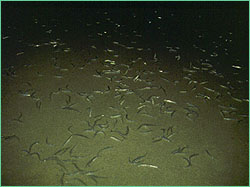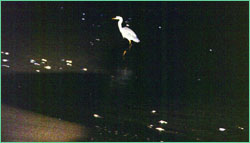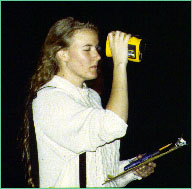|
|
|
|
 |
Shore Birds—Jennifer GriemOn a balmy night in 1996, biologist Jennifer Griem found herself observing a late night beach phenomenon unique to southern California: a grunion run. Grunion are small fish who spawn once every two weeks during the summer months by temporarily beaching themselves. Taking advance of the highest high tides, the grunion lay their eggs in the sand, where they incubate until they are washed back into the ocean two weeks later. As impressive as the grunion spectacle was, Griem was more fascinated by the array of birds she observed lining up for an easy grunion meal: Great Blue Herons, Night Herons, Western Gulls and Snowy Egrets.  NOVA: What's so interesting about a bunch of birds
taking advantage of a grunion run?
NOVA: What's so interesting about a bunch of birds
taking advantage of a grunion run?JG: Of the four bird species that feed on the grunion, there's only one that's truly nocturnal—the Night Heron. The other three are usually daytime feeders, but they come out at night for grunion runs. So we're seeing daytime feeders coming out and engaging in nocturnal behavior, which is very interesting. It prompted me to get going and do some population counts and some correlations between grunion runs and the appearance of birds on the beach.  NOVA: Tell me about the technology that you used.
NOVA: Tell me about the technology that you used.JG: Well, I had a pair of binoculars, which is pretty standard. The other instrument I used was an ITT night vision scope. It was a monocular, so I looked through it with only one eye. It takes whatever small amount of light is on the beach and it multiplies it so that you see very clearly—almost like it's daylight. It's the same technology that the military uses for their night exercises. NOVA: Where did you get it?  JG: We got ours at a marine store, because it was
waterproof, but they have them at hunting stores, too. I think
the one we got was over $1000, which is fairly expensive, but
it works tremendously well. It enabled me to identify the
birds, to species, at night—by their silhouette and
their markings. And it enabled me to do accurate counts
without having to get too close to them and scare them away.
It was a real useful piece of equipment.
JG: We got ours at a marine store, because it was
waterproof, but they have them at hunting stores, too. I think
the one we got was over $1000, which is fairly expensive, but
it works tremendously well. It enabled me to identify the
birds, to species, at night—by their silhouette and
their markings. And it enabled me to do accurate counts
without having to get too close to them and scare them away.
It was a real useful piece of equipment.NOVA: What did the night vision scope enable you to learn about the birds and their relationship with the grunion that you otherwise would have missed? JG: I learned that the birds are present not only during grunion runs, but before grunion runs. Like a half an hour before the fish even show up, they're there waiting. And they're not there on nights when the fish are not supposed to come. They actually know when the fish are coming. (back) Photos: (1,3) Karen Martin, Pepperdine University; (2) Stephen Davis, Pepperdine University. Night Vision | Zoology After Dark Resources | Guide | Transcript | Night Creatures Home Editor's Picks | Previous Sites | Join Us/E-mail | TV/Web Schedule About NOVA | Teachers | Site Map | Shop | Jobs | Search | To print PBS Online | NOVA Online | WGBH © | Updated November 2000 |